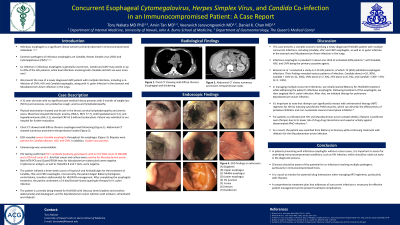Monday Poster Session
Category: Esophagus
P2310 - Concurrent Esophageal Cytomegalovirus, Herpes Simplex Virus, and Candida Coinfection in an Immunocompromised Patient: A Case Report
Monday, October 28, 2024
10:30 AM - 4:00 PM ET
Location: Exhibit Hall E

Has Audio
- TN
Toru Nakata, MD, PhD
University of Hawaii, John A. Burns School of Medicine
Honolulu, HI
Presenting Author(s)
Toru Nakata, MD, PhD1, Arvin Jeremy. Tan, MD2, Veeravich Jaruvongvanich, MD3, Daniel K. Chan, MD3
1University of Hawaii, John A. Burns School of Medicine, Honolulu, HI; 2John A. Burns School of Medicine, University of Hawaii, Honolulu, HI; 3Queen's Medical Center, Ewa Beach, HI
Introduction: Infectious esophagitis is a significant clinical concern primarily observed in immunocompromised individuals 1,2. Among a variety of pathogens, Candida, Cytomegalovirus (CMV) and Herpes Simplex virus (HSV) are the most frequently encountered. While co-infections of CMV with Candida or HSV are rare, they pose significant risks due to the poor prognosis associated with CMV esophagitis, including high recurrence rates and mortality. Here, we discuss a case of a patient with HIV presenting with CMV, HSV, and Candida esophagitis co-infection.
Case Description/Methods: A 31-year-old male with no significant past medical history presents with 6 months of weight loss and anorexia, productive cough, anemia (Hb 6.5), and lymphadenopathy. Physical examination showed oral thrush in the throat and lymphadenopathy in the neck. After transfusion, the patient was admitted to our hospital. Upper gastrointestinal endoscopy revealed severe Candida esophagitis throughout the esophagus. Biopsies were positive for Candida albicans, HSV, and CMV. In addition, H.pylori was positive. Colonoscopy was unremarkable. These findings raised concern for immunodeficiency. HIV testing was performed and found to be HIV-1 Ab positive, genotype B, HIV DNA 580,000, CD4 cell count 3. Cryptococcus Ag was negative. Acid-Fast Smear and culture were positive for Mycobacterium Avium. MTB PCR and MTB Quantiferon were negative. Hepatitis B and C were negative. The patient started a three-week course of Acyclovir and Anidulafungin treatment. Additionally, after the patient was diagnosed with HIV/AIDS, the patient also started Biktarvy. The patient is now following up in the outpatient setting. Repeat EGD is scheduled in 3 months.
Discussion: This case presents a complex scenario involving a newly diagnosed HIV/AIDS patient with multiple infections, including Candida, HSV, and CMV esophagitis, as well as H. pylori induction and Mycobacterium Avium infection in the lungs. Candida, HSV, and CMV are the primary culprits of infectious esophagitis, although co-infections of Candida with HSV or CMV are uncommon. Bonacini et al2 conducted a study on 110 HIV patients, of which 72 (65%) exhibited esophageal infections. Their findings revealed various patterns of infection: Candida alone (n=33, 30%), Candida + CMV (n=22, 20%), CMV alone (n=7, 6%), HSV alone (n=6, 5%), and Candida + CMV + HSV (n=2, 1.8%). In managing esophagitis in immunosuppressed patients, clinicians should be mindful of the potential for co-infections involving multiple pathogens.

Disclosures:
Toru Nakata, MD, PhD1, Arvin Jeremy. Tan, MD2, Veeravich Jaruvongvanich, MD3, Daniel K. Chan, MD3. P2310 - Concurrent Esophageal Cytomegalovirus, Herpes Simplex Virus, and Candida Coinfection in an Immunocompromised Patient: A Case Report, ACG 2024 Annual Scientific Meeting Abstracts. Philadelphia, PA: American College of Gastroenterology.
1University of Hawaii, John A. Burns School of Medicine, Honolulu, HI; 2John A. Burns School of Medicine, University of Hawaii, Honolulu, HI; 3Queen's Medical Center, Ewa Beach, HI
Introduction: Infectious esophagitis is a significant clinical concern primarily observed in immunocompromised individuals 1,2. Among a variety of pathogens, Candida, Cytomegalovirus (CMV) and Herpes Simplex virus (HSV) are the most frequently encountered. While co-infections of CMV with Candida or HSV are rare, they pose significant risks due to the poor prognosis associated with CMV esophagitis, including high recurrence rates and mortality. Here, we discuss a case of a patient with HIV presenting with CMV, HSV, and Candida esophagitis co-infection.
Case Description/Methods: A 31-year-old male with no significant past medical history presents with 6 months of weight loss and anorexia, productive cough, anemia (Hb 6.5), and lymphadenopathy. Physical examination showed oral thrush in the throat and lymphadenopathy in the neck. After transfusion, the patient was admitted to our hospital. Upper gastrointestinal endoscopy revealed severe Candida esophagitis throughout the esophagus. Biopsies were positive for Candida albicans, HSV, and CMV. In addition, H.pylori was positive. Colonoscopy was unremarkable. These findings raised concern for immunodeficiency. HIV testing was performed and found to be HIV-1 Ab positive, genotype B, HIV DNA 580,000, CD4 cell count 3. Cryptococcus Ag was negative. Acid-Fast Smear and culture were positive for Mycobacterium Avium. MTB PCR and MTB Quantiferon were negative. Hepatitis B and C were negative. The patient started a three-week course of Acyclovir and Anidulafungin treatment. Additionally, after the patient was diagnosed with HIV/AIDS, the patient also started Biktarvy. The patient is now following up in the outpatient setting. Repeat EGD is scheduled in 3 months.
Discussion: This case presents a complex scenario involving a newly diagnosed HIV/AIDS patient with multiple infections, including Candida, HSV, and CMV esophagitis, as well as H. pylori induction and Mycobacterium Avium infection in the lungs. Candida, HSV, and CMV are the primary culprits of infectious esophagitis, although co-infections of Candida with HSV or CMV are uncommon. Bonacini et al2 conducted a study on 110 HIV patients, of which 72 (65%) exhibited esophageal infections. Their findings revealed various patterns of infection: Candida alone (n=33, 30%), Candida + CMV (n=22, 20%), CMV alone (n=7, 6%), HSV alone (n=6, 5%), and Candida + CMV + HSV (n=2, 1.8%). In managing esophagitis in immunosuppressed patients, clinicians should be mindful of the potential for co-infections involving multiple pathogens.

Figure: Fig.1 EGD images
Disclosures:
Toru Nakata indicated no relevant financial relationships.
Arvin Tan indicated no relevant financial relationships.
Veeravich Jaruvongvanich indicated no relevant financial relationships.
Daniel Chan indicated no relevant financial relationships.
Toru Nakata, MD, PhD1, Arvin Jeremy. Tan, MD2, Veeravich Jaruvongvanich, MD3, Daniel K. Chan, MD3. P2310 - Concurrent Esophageal Cytomegalovirus, Herpes Simplex Virus, and Candida Coinfection in an Immunocompromised Patient: A Case Report, ACG 2024 Annual Scientific Meeting Abstracts. Philadelphia, PA: American College of Gastroenterology.
